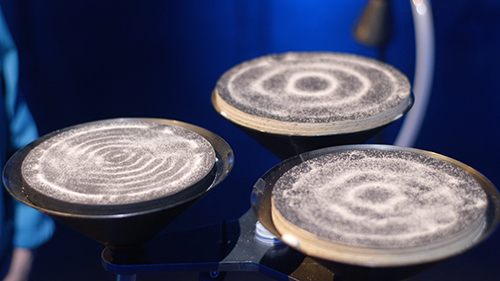Four Vibrations
(i)
I want to make words vibrate.
Not with the sounds of their phonemes but with their meanings.
(ii)
I worry that there is a tremor in my hand
I worry that I can feel a quiver through me.
Anxiety is an excess of vibration.
(iii)
Sound is vibration shared through different materials.
In air we can't see its shapes,
but in matter it manifests its beautiful geometries. (1)

Cymatics is the study of patterns that emerge in liquids and powders in response to sound vibrations. This image is of a tridophone, designed by Thomas Burless for our performance/installation project A continuous self-vibrating region of intensities, 2019. It is based on the eidophone, designed by Margaret Watts Hughes (1885). Patterns are manifested in fine powder spread on a flexible membrane in response to the sound of the voice at various frequencies. These patterns were created by guest artist, Carolyn Connors.
(iv)
There’s a theory—
it’s one of those theories that makes so much sense that it is considered too good to be true—
that consciousness occurs when brainwaves are in synch,
when they have reached a particular frequency,
all synapses spurting at the same intensity.
This is the moment we feel ourselves,
as ourselves. (2)I am alluding to Francis Crick and Christoph Koch's hypothesis that consciousness occurs when neurons across different areas of the brain fire synchronously at 40 Hz, or 40 firings per second. There is a lovely simplicity to this theory, however it has yet to be proven (Grim, 2008, p. 115–116).
This is what I like to think happens with listening.
The vibrations sync up with our synapses
and there is moment of clarity,
a clarity of moment,
when we know
where we are,
who we are,
why we are.
Notes
 image is of a tridophone, designed by Thomas Burless for our performance/installation project A continuous self-vibrating region of intensities, 2019. (i) Priest, G., & Burless, T. (2019). A continuous self-vibrating region of intensities [Sound installation/performance].It is based on the eidophone designed by Margaret Watts Hughes (1885). Patterns are manifested in fine powder spread on a flexible membrane in response to the sound of the voice at various frequencies. These patterns were created by guest artist, Carolyn Connors. This project is discussed further in module (i): Listening to My Listening—Practice Notes.
image is of a tridophone, designed by Thomas Burless for our performance/installation project A continuous self-vibrating region of intensities, 2019. (i) Priest, G., & Burless, T. (2019). A continuous self-vibrating region of intensities [Sound installation/performance].It is based on the eidophone designed by Margaret Watts Hughes (1885). Patterns are manifested in fine powder spread on a flexible membrane in response to the sound of the voice at various frequencies. These patterns were created by guest artist, Carolyn Connors. This project is discussed further in module (i): Listening to My Listening—Practice Notes.